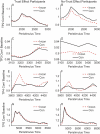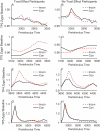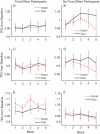The role of emotion in learning trustworthiness from eye-gaze: Evidence from facial electromyography
- PMID: 27153239
- PMCID: PMC4867790
- DOI: 10.1080/17588928.2015.1085374
The role of emotion in learning trustworthiness from eye-gaze: Evidence from facial electromyography
Abstract
Gaze direction can be used to rapidly and reflexively lead or mislead others' attention as to the location of important stimuli. When perception of gaze direction is congruent with the location of a target, responses are faster compared to when incongruent. Faces that consistently gaze congruently are also judged more trustworthy than faces that consistently gaze incongruently. However, it's unclear how gaze-cues elicit changes in trust. We measured facial electromyography (EMG) during an identity-contingent gaze-cueing task to examine whether embodied emotional reactions to gaze-cues mediate trust learning. Gaze-cueing effects were found to be equivalent regardless of whether participants showed learning of trust in the expected direction or did not. In contrast, we found distinctly different patterns of EMG activity in these two populations. In a further experiment we showed the learning effects were specific to viewing faces, as no changes in liking were detected when viewing arrows that evoked similar attentional orienting responses. These findings implicate embodied emotion in learning trust from identity-contingent gaze-cueing, possibly due to the social value of shared attention or deception rather than domain-general attentional orienting.
Keywords: Emotion; Face evaluation; Facial EMG; Gaze-cueing; Trustworthiness.
Figures











Similar articles
-
The Effect of Trust on Gaze-Mediated Attentional Orienting.Front Psychol. 2020 Jul 15;11:1554. doi: 10.3389/fpsyg.2020.01554. eCollection 2020. Front Psychol. 2020. PMID: 32765355 Free PMC article. Review.
-
The late positive potential indexes a role for emotion during learning of trust from eye-gaze cues.Soc Neurosci. 2015;10(6):635-50. doi: 10.1080/17470919.2015.1017114. Epub 2015 Mar 3. Soc Neurosci. 2015. PMID: 25731599 Free PMC article.
-
Incidental learning of trust: Examining the role of emotion and visuomotor fluency.J Exp Psychol Learn Mem Cogn. 2016 Nov;42(11):1759-1773. doi: 10.1037/xlm0000270. Epub 2016 Mar 31. J Exp Psychol Learn Mem Cogn. 2016. PMID: 27031325
-
Self-relevance appraisal of gaze direction and dynamic facial expressions: effects on facial electromyographic and autonomic reactions.Emotion. 2013 Apr;13(2):330-7. doi: 10.1037/a0029892. Epub 2012 Sep 17. Emotion. 2013. PMID: 22985342
-
Are there quantitative differences between eye-gaze and arrow cues? A meta-analytic answer to the debate and a call for qualitative differences.Neurosci Biobehav Rev. 2023 Jan;144:104993. doi: 10.1016/j.neubiorev.2022.104993. Epub 2022 Dec 7. Neurosci Biobehav Rev. 2023. PMID: 36496190 Review.
Cited by
-
Spatial compatibility interference effects: a double dissociation between two measures.Vis cogn. 2015 Sep 14;23(8):1043-1060. doi: 10.1080/13506285.2015.1110653. Epub 2015 Dec 11. Vis cogn. 2015. PMID: 26924937 Free PMC article.
-
Illumination and gaze effects on face evaluation: The Bi-AGI database.Front Psychol. 2022 Oct 13;13:948142. doi: 10.3389/fpsyg.2022.948142. eCollection 2022. Front Psychol. 2022. PMID: 36312184 Free PMC article.
-
The who and the where: Attention to identities and locations in groups.Atten Percept Psychophys. 2024 Jul;86(5):1816-1832. doi: 10.3758/s13414-024-02879-6. Epub 2024 May 9. Atten Percept Psychophys. 2024. PMID: 38724727 Free PMC article.
-
Incidental retrieval of prior emotion mimicry.Exp Brain Res. 2017 Apr;235(4):1173-1184. doi: 10.1007/s00221-017-4882-y. Epub 2017 Feb 10. Exp Brain Res. 2017. PMID: 28188326 Free PMC article.
-
The Effect of Trust on Gaze-Mediated Attentional Orienting.Front Psychol. 2020 Jul 15;11:1554. doi: 10.3389/fpsyg.2020.01554. eCollection 2020. Front Psychol. 2020. PMID: 32765355 Free PMC article. Review.
References
-
- Armel K. C., Pulido C., Wixted J. T., Chiba A. A. The smart gut: Tracking affective associative learning with measures of “liking’, facial electromyography, and preferential looking. Learning and Motivation. 2009;40:74–93. doi: 10.1016/j.lmot.2008.06.003. - DOI
Publication types
MeSH terms
LinkOut - more resources
Full Text Sources
Other Literature Sources
